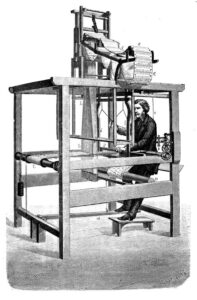Weaving fibers to form a fabric has been a part of human existence since ancient times. Weaving is the process of interlacing longitudinally oriented warp threads with horizontally oriented weft threads to form a woven fabric. Weaving is performed on a loom, a device arranged to hold warp threads under tension while allowing the weft threads to be sequentially added to them, to produce a fabric. The relative movement and positioning of the warp and weft threads during the weaving process results in a sequence of thread placements that together form a pattern in the finished fabric. To change patterns, the sequence of thread placements must be modified, a traditionally labor and time intensive process. Through the centuries, looms have had a variety of configurations, but their basic function has remained the same.
placements that together form a pattern in the finished fabric. To change patterns, the sequence of thread placements must be modified, a traditionally labor and time intensive process. Through the centuries, looms have had a variety of configurations, but their basic function has remained the same.
Loom technology has seen a variety of innovations throughout history in a continuous effort to make fabric production faster, easier, and more cost-effective. The Jacquard machine invented by French weaver Joseph-Marie Jacquard (born 1752 in Lyon, France) revolutionized the field of weaving. His invention, which uses punch cards to represent a desired sequence of thread placements during operation of the loom, greatly reduced the labor involved in the process of weaving. Jacquard designed a device that would be attached to a loom to control the placement of individual warp threads according to a pre-set progression of steps represented and controlled by a pattern of holes in each of a set of punch cards. This allowed looms to not only produce complex textile patterns such as brocade, damask, and lace, but also to be changed quickly from one pattern to another. By simply exchanging a first set of punch cards for a second set of punch cards, the loom could be reprogrammed to produce a new fabric pattern. Jacquard looms are used for weaving all sorts of intricate patterned textiles. They could be programmed to weave a single pattern fabric or a combination of patterns with different colors. The Jacquard loom sped up the process of weaving complex textiles, allowing factory owners to increase their profit margins and scale up their business. Moreover, the invention was revolutionary because it used interchangeable sets of punch cards, each set representing a distinct fabric pattern, as a means for programming the loom’s output. This innovation also produced a new class of technically skilled workers who were employed to prepare the punch card sets as well as to operate, maintain, and repair these programmable machines. This new class of highly skilled technicians became vital to the progress of the Industrial Revolution.
The Jacquard loom sped up the process of weaving complex textiles, allowing factory owners to increase their profit margins and scale up their business. Moreover, the invention was revolutionary because it used interchangeable sets of punch cards, each set representing a distinct fabric pattern, as a means for programming the loom’s output. This innovation also produced a new class of technically skilled workers who were employed to prepare the punch card sets as well as to operate, maintain, and repair these programmable machines. This new class of highly skilled technicians became vital to the progress of the Industrial Revolution.
Jacquard’s innovation was a great success and soon in widespread use throughout the industrialized world. It was a major contribution to the field of textile manufacturing and is now considered to be one of the most important technological innovations of the nineteenth century. The concept of employing sets of punch cards to represent a series of machine operations led directly to their use in Charles Babbage’s Analytical Engine, a precursor to the modern computer.
